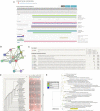Computational analysis on two putative mitochondrial protein-coding genes from the Emydura subglobosa genome: A functional annotation approach
- PMID: 35981005
- PMCID: PMC9387794
- DOI: 10.1371/journal.pone.0268031
Computational analysis on two putative mitochondrial protein-coding genes from the Emydura subglobosa genome: A functional annotation approach
Abstract
Rapid advancements in automated genomic technologies have uncovered many unique findings about the turtle genome and its associated features including olfactory gene expansions and duplications of toll-like receptors. However, despite the advent of large-scale sequencing, assembly, and annotation, about 40-50% of genes in eukaryotic genomes are left without functional annotation, severely limiting our knowledge of the biological information of genes. Additionally, these automated processes are prone to errors since draft genomes consist of several disconnected scaffolds whose order is unknown; erroneous draft assemblies may also be contaminated with foreign sequences and propagate to cause errors in annotation. Many of these automated annotations are thus incomplete and inaccurate, highlighting the need for functional annotation to link gene sequences to biological identity. In this study, we have functionally annotated two genes of the red-bellied short-neck turtle (Emydura subglobosa), a member of the relatively understudied pleurodire lineage of turtles. We improved upon initial ab initio gene predictions through homology-based evidence and generated refined consensus gene models. Through functional, localization, and structural analyses of the predicted proteins, we discovered conserved putative genes encoding mitochondrial proteins that play a role in C21-steroid hormone biosynthetic processes and fatty acid catabolism-both of which are distantly related by the tricarboxylic acid (TCA) cycle and share similar metabolic pathways. Overall, these findings further our knowledge about the genetic features underlying turtle physiology, morphology, and longevity, which have important implications for the treatment of human diseases and evolutionary studies.
Conflict of interest statement
The authors have declared that no competing interests exist.
Figures








Similar articles
-
[Analysis, identification and correction of some errors of model refseqs appeared in NCBI Human Gene Database by in silico cloning and experimental verification of novel human genes].Yi Chuan Xue Bao. 2004 May;31(5):431-43. Yi Chuan Xue Bao. 2004. PMID: 15478601 Chinese.
-
Discovery of a New TLR Gene and Gene Expansion Event through Improved Desert Tortoise Genome Assembly with Chromosome-Scale Scaffolds.Genome Biol Evol. 2020 Feb 1;12(2):3917-3925. doi: 10.1093/gbe/evaa016. Genome Biol Evol. 2020. PMID: 32011707 Free PMC article.
-
Discovery of Putative XX/XY Male Heterogamety in Emydura subglobosa Turtles Exposes a Novel Trajectory of Sex Chromosome Evolution in Emydura.Cytogenet Genome Res. 2019;158(3):160-169. doi: 10.1159/000501891. Epub 2019 Aug 9. Cytogenet Genome Res. 2019. PMID: 31394537
-
Review on the Computational Genome Annotation of Sequences Obtained by Next-Generation Sequencing.Biology (Basel). 2020 Sep 18;9(9):295. doi: 10.3390/biology9090295. Biology (Basel). 2020. PMID: 32962098 Free PMC article. Review.
-
Genome annotation: From human genetics to biodiversity genomics.Cell Genom. 2023 Aug 1;3(8):100375. doi: 10.1016/j.xgen.2023.100375. eCollection 2023 Aug 9. Cell Genom. 2023. PMID: 37601977 Free PMC article. Review.
References
-
- Turtle Taxonomy Working Group, Rhodin AGJ. Turtles of the World: Annotated Checklist and Atlas of Taxonomy, Synonymy, Distribution, and Conservation Status (9th Ed.). [Internet]. First. Chelonian Research Foundation and Turtle Conservancy; 2021 [cited 2022 May 5]. (Rhodin A, editor. Chelonian Research Monographs; vol. 8). Available from: https://iucn-tftsg.org/checklist/
MeSH terms
Substances
LinkOut - more resources
Full Text Sources

